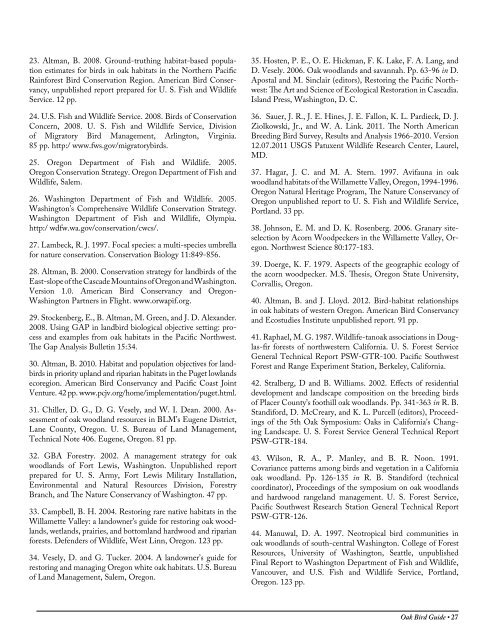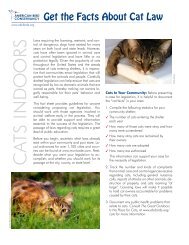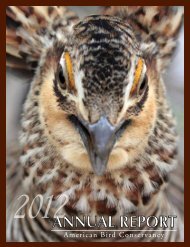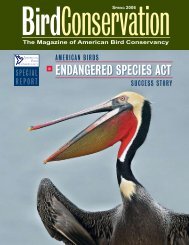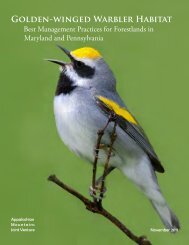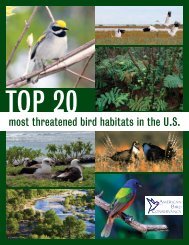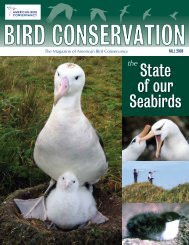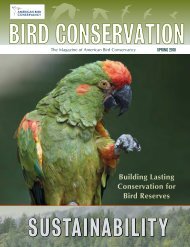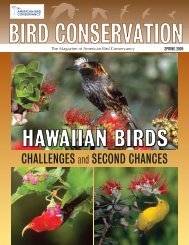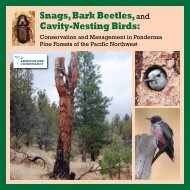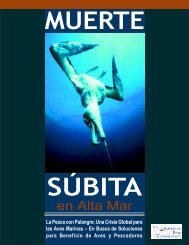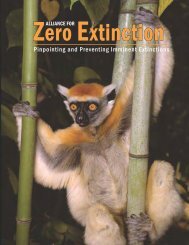Oak Ecosystems in the Pacific Northwest - American Bird Conservancy
Oak Ecosystems in the Pacific Northwest - American Bird Conservancy
Oak Ecosystems in the Pacific Northwest - American Bird Conservancy
You also want an ePaper? Increase the reach of your titles
YUMPU automatically turns print PDFs into web optimized ePapers that Google loves.
23. Altman, B. 2008. Ground-truth<strong>in</strong>g habitat-based population<br />
estimates for birds <strong>in</strong> oak habitats <strong>in</strong> <strong>the</strong> Nor<strong>the</strong>rn <strong>Pacific</strong><br />
Ra<strong>in</strong>forest <strong>Bird</strong> Conservation Region. <strong>American</strong> <strong>Bird</strong> <strong>Conservancy</strong>,<br />
unpublished report prepared for U. S. Fish and Wildlife<br />
Service. 12 pp.<br />
24. U.S. Fish and Wildlife Service. 2008. <strong>Bird</strong>s of Conservation<br />
Concern, 2008. U. S. Fish and Wildlife Service, Division<br />
of Migratory <strong>Bird</strong> Management, Arl<strong>in</strong>gton, Virg<strong>in</strong>ia.<br />
85 pp. http:/ www.fws.gov/migratorybirds.<br />
25. Oregon Department of Fish and Wildlife. 2005.<br />
Oregon Conservation Strategy. Oregon Department of Fish and<br />
Wildlife, Salem.<br />
26. Wash<strong>in</strong>gton Department of Fish and Wildlife. 2005.<br />
Wash<strong>in</strong>gton’s Comprehensive Wildlife Conservation Strategy.<br />
Wash<strong>in</strong>gton Department of Fish and Wildlife, Olympia.<br />
http:/ wdfw.wa.gov/conservation/cwcs/.<br />
27. Lambeck, R. J. 1997. Focal species: a multi-species umbrella<br />
for nature conservation. Conservation Biology 11:849-856.<br />
28. Altman, B. 2000. Conservation strategy for landbirds of <strong>the</strong><br />
East-slope of <strong>the</strong> Cascade Mounta<strong>in</strong>s of Oregon and Wash<strong>in</strong>gton.<br />
Version 1.0. <strong>American</strong> <strong>Bird</strong> <strong>Conservancy</strong> and Oregon-<br />
Wash<strong>in</strong>gton Partners <strong>in</strong> Flight. www.orwapif.org.<br />
29. Stockenberg, E., B. Altman, M. Green, and J. D. Alexander.<br />
2008. Us<strong>in</strong>g GAP <strong>in</strong> landbird biological objective sett<strong>in</strong>g: process<br />
and examples from oak habitats <strong>in</strong> <strong>the</strong> <strong>Pacific</strong> <strong>Northwest</strong>.<br />
The Gap Analysis Bullet<strong>in</strong> 15:34.<br />
30. Altman, B. 2010. Habitat and population objectives for landbirds<br />
<strong>in</strong> priority upland and riparian habitats <strong>in</strong> <strong>the</strong> Puget lowlands<br />
ecoregion. <strong>American</strong> <strong>Bird</strong> <strong>Conservancy</strong> and <strong>Pacific</strong> Coast Jo<strong>in</strong>t<br />
Venture. 42 pp. www.pcjv.org/home/implementation/puget.html.<br />
31. Chiller, D. G., D. G. Vesely, and W. I. Dean. 2000. Assessment<br />
of oak woodland resources <strong>in</strong> BLM’s Eugene District,<br />
Lane County, Oregon. U. S. Bureau of Land Management,<br />
Technical Note 406. Eugene, Oregon. 81 pp.<br />
32. GBA Forestry. 2002. A management strategy for oak<br />
woodlands of Fort Lewis, Wash<strong>in</strong>gton. Unpublished report<br />
prepared for U. S. Army, Fort Lewis Military Installation,<br />
Environmental and Natural Resources Division, Forestry<br />
Branch, and The Nature <strong>Conservancy</strong> of Wash<strong>in</strong>gton. 47 pp.<br />
33. Campbell, B. H. 2004. Restor<strong>in</strong>g rare native habitats <strong>in</strong> <strong>the</strong><br />
Willamette Valley: a landowner’s guide for restor<strong>in</strong>g oak woodlands,<br />
wetlands, prairies, and bottomland hardwood and riparian<br />
forests. Defenders of Wildlife, West L<strong>in</strong>n, Oregon. 123 pp.<br />
34. Vesely, D. and G. Tucker. 2004. A landowner’s guide for<br />
restor<strong>in</strong>g and manag<strong>in</strong>g Oregon white oak habitats. U.S. Bureau<br />
of Land Management, Salem, Oregon.<br />
35. Hosten, P. E., O. E. Hickman, F. K. Lake, F. A. Lang, and<br />
D. Vesely. 2006. <strong>Oak</strong> woodlands and savannah. Pp. 63-96 <strong>in</strong> D.<br />
Apostal and M. S<strong>in</strong>clair (editors), Restor<strong>in</strong>g <strong>the</strong> <strong>Pacific</strong> <strong>Northwest</strong>:<br />
The Art and Science of Ecological Restoration <strong>in</strong> Cascadia.<br />
Island Press, Wash<strong>in</strong>gton, D. C.<br />
36. Sauer, J. R., J. E. H<strong>in</strong>es, J. E. Fallon, K. L. Pardieck, D. J.<br />
Ziolkowski, Jr., and W. A. L<strong>in</strong>k. 2011. The North <strong>American</strong><br />
Breed<strong>in</strong>g <strong>Bird</strong> Survey, Results and Analysis 1966-2010. Version<br />
12.07.2011 USGS Patuxent Wildlife Research Center, Laurel,<br />
MD.<br />
37. Hagar, J. C. and M. A. Stern. 1997. Avifauna <strong>in</strong> oak<br />
woodland habitats of <strong>the</strong> Willamette Valley, Oregon, 1994-1996.<br />
Oregon Natural Heritage Program, The Nature <strong>Conservancy</strong> of<br />
Oregon unpublished report to U. S. Fish and Wildlife Service,<br />
Portland. 33 pp.<br />
38. Johnson, E. M. and D. K. Rosenberg. 2006. Granary siteselection<br />
by Acorn Woodpeckers <strong>in</strong> <strong>the</strong> Willamette Valley, Oregon.<br />
<strong>Northwest</strong> Science 80:177-183.<br />
39. Doerge, K. F. 1979. Aspects of <strong>the</strong> geographic ecology of<br />
<strong>the</strong> acorn woodpecker. M.S. Thesis, Oregon State University,<br />
Corvallis, Oregon.<br />
40. Altman, B. and J. Lloyd. 2012. <strong>Bird</strong>-habitat relationships<br />
<strong>in</strong> oak habitats of western Oregon. <strong>American</strong> <strong>Bird</strong> <strong>Conservancy</strong><br />
and Ecostudies Institute unpublished report. 91 pp.<br />
41. Raphael, M. G. 1987. Wildlife-tanoak associations <strong>in</strong> Douglas-fir<br />
forests of northwestern California. U. S. Forest Service<br />
General Technical Report PSW-GTR-100. <strong>Pacific</strong> Southwest<br />
Forest and Range Experiment Station, Berkeley, California.<br />
42. Stralberg, D and B. Williams. 2002. Effects of residential<br />
development and landscape composition on <strong>the</strong> breed<strong>in</strong>g birds<br />
of Placer County’s foothill oak woodlands. Pp. 341-363 <strong>in</strong> R. B.<br />
Standiford, D. McCreary, and K. L. Purcell (editors), Proceed<strong>in</strong>gs<br />
of <strong>the</strong> 5th <strong>Oak</strong> Symposium: <strong>Oak</strong>s <strong>in</strong> California’s Chang<strong>in</strong>g<br />
Landscape. U. S. Forest Service General Technical Report<br />
PSW-GTR-184.<br />
43. Wilson, R. A., P. Manley, and B. R. Noon. 1991.<br />
Covariance patterns among birds and vegetation <strong>in</strong> a California<br />
oak woodland. Pp. 126-135 <strong>in</strong> R. B. Standiford (technical<br />
coord<strong>in</strong>ator), Proceed<strong>in</strong>gs of <strong>the</strong> symposium on oak woodlands<br />
and hardwood rangeland management. U. S. Forest Service,<br />
<strong>Pacific</strong> Southwest Research Station General Technical Report<br />
PSW-GTR-126.<br />
44. Manuwal, D. A. 1997. Neotropical bird communities <strong>in</strong><br />
oak woodlands of south-central Wash<strong>in</strong>gton. College of Forest<br />
Resources, University of Wash<strong>in</strong>gton, Seattle, unpublished<br />
F<strong>in</strong>al Report to Wash<strong>in</strong>gton Department of Fish and Wildlife,<br />
Vancouver, and U.S. Fish and Wildlife Service, Portland,<br />
Oregon. 123 pp.<br />
<strong>Oak</strong> <strong>Bird</strong> Guide • 27


